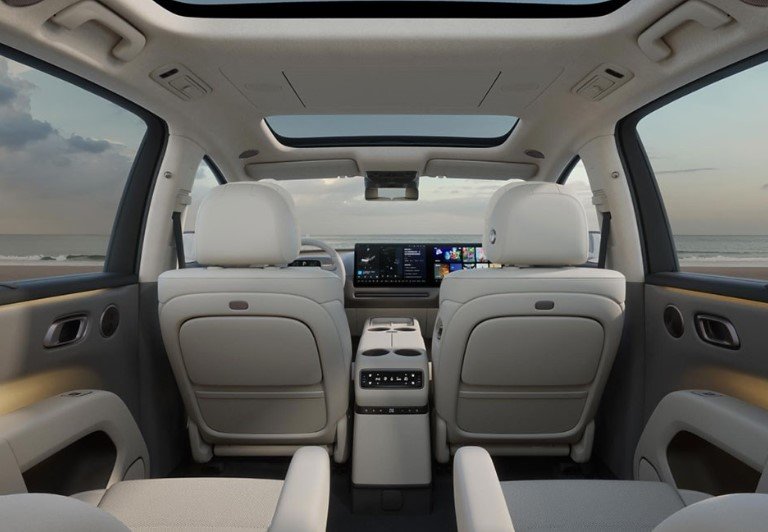Li i8 debuts with 6 seats, premium pricing, and a bold promise to redefine family mobility in a crowded EV market
Li Auto’s latest SUV is officially in the ring. And it’s swinging at Tesla.
The Chinese EV darling has unveiled the Li i8, a six-seat, high-tech electric SUV—marking its first step into the fully electric market after years of hybrid-style range-extenders. The move directly challenges Tesla’s new 6-seat Model Y offering in China, where both companies are battling for attention, market share, and brand loyalty.
Two 6-seaters. One big showdown.
Tesla probably didn’t expect its 6-seat Model Y, released just days ago, to be outflanked this quickly.
But that’s exactly what happened. And while Tesla’s brand still carries weight in China, its momentum has slowed. The Model Y dropped to #4 among plug-in vehicles in the country from January to June. In contrast, Li Auto has been building buzz as a local favorite with massive, tech-packed SUVs that feel more like luxury lounges than commuter cars.
Now with the Li i8, it’s stepping away from its gasoline range-extender past—and heading straight into Tesla’s lane.
And what does it bring? Comfort, muscle, and tech swagger.
The pricing? Not exactly a bargain—but there’s plenty packed in
Let’s be honest: this isn’t a budget EV.
The Li i8 comes in three versions:
-
Pro – RMB321,800 (roughly $44,840)
-
Max – RMB349,800 ($48,740)
-
Ultra – RMB369,800 ($51,530)
Those numbers push the i8 well into premium territory, even for China. But then again, Li isn’t aiming at budget shoppers. This is a brand that sells luxury-level interiors, panoramic screens, AI-powered cockpit assistants, and now—its own ultra-fast charging infrastructure.
One sentence here: this is the first time Li Auto is offering an all-electric, all-original platform.

A new tech platform built from scratch
Li Auto is calling it the “5C” era. And not just as a marketing trick.
The i8 rides on a new high-voltage battery electric platform developed entirely in-house. It includes a bespoke electric drive system, 5C battery cells (translation: way faster charging), and access to Li Auto’s growing national 5C supercharging network.
For context, most EVs today use 1C or 2C charging. That means 5C, in theory, could deliver five times faster charge rates under ideal conditions. Think 10-80% in under 12 minutes. That’s a pretty big leap—even if real-world results fall a bit short.
And Li is serious about infrastructure. The company says its nationwide 5C network is already rolling out, though it didn’t say exactly how many stations are live right now.
What the Li i8 actually offers behind the marketing fluff
There’s always fluff. But there’s also a real product underneath, and here’s what buyers are getting with the i8:
-
All-terrain capabilities paired with sedan-like handling
-
Ride comfort on par with MPVs (multi-purpose vans)
-
Six roomy seats across three rows
-
Fully electric platform (no gas backup this time)
-
Dual-motor AWD setup with up to 400kW combined output
-
Huge infotainment screens + voice interaction
-
Smart air suspension and active noise cancellation
The promise is simple: this isn’t just a car, it’s a rolling living room that doesn’t need gasoline. That’s the pitch.
Why now? And why this configuration?
Timing matters. And this launch feels very deliberate.
Tesla’s 6-seat Model Y expansion was supposed to bring some excitement to a maturing Chinese EV market. But Li Auto clearly had other plans.
This move also reflects two larger shifts:
-
China’s EV buyers are getting more demanding. They want comfort, tech, and status—beyond just the electric powertrain.
-
Li Auto needs to prove it can thrive without gas. All its previous hits were extended-range vehicles. The i8 is a bet on full battery-electric future—and investor patience.
And it’s not a small bet.
Li Auto’s EV rollout strategy compared to competitors
Let’s look at how Li Auto stacks up against some of its biggest domestic rivals on key features:
| Brand | Fully Electric Models | Charging Network | Price Range (6-seaters) | Domestic Brand Loyalty |
|---|---|---|---|---|
| Li Auto | 1 (Li i8) | 5C Superchargers | $44,800–$51,500 | Strong (family buyers) |
| NIO | Several | Battery Swap | $50,000+ | Moderate (tech lovers) |
| XPeng | Several | X-Power Chargers | $30,000–$50,000 | Mixed |
| Tesla | 2 (3, Y) | Supercharger | $40,000–$53,000 | Strong (early adopters) |
One-sentence paragraph here: All four brands are betting on different charging strategies.
Tesla still leads in global charging coverage, but domestically, Li’s localized 5C strategy might appeal more to users outside the major metro bubbles.
Will Chinese families go for it?
This is the real question. Because on paper, the i8 looks like a dream machine.
But China’s middle-class families are cost-conscious. They don’t just look at upfront pricing—they factor in battery life, resale value, maintenance costs, and even the ride height. So a flashy launch doesn’t always translate to sales.
That said, Li Auto does have a reputation. Buyers trust its quality. And the six-seat configuration, oddly underrepresented in the Chinese EV market, could hit a sweet spot for urban families who shuttle kids and grandparents all in one go.
Also, with Tesla’s momentum softening in China and new brands emerging almost every quarter, the Li i8’s timing couldn’t be more strategic.
Whether it’s enough to actually unseat the Model Y? Too early to tell. But the battle’s heating up—and the parking lots might get a lot more crowded with these oversized, software-loaded family ships.








